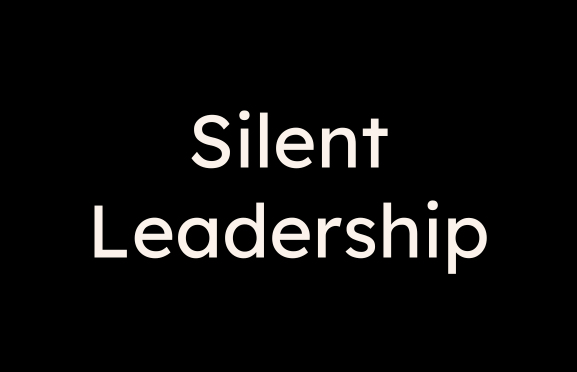
The Quiet Revolution: Silent Leadership in a Loud World
By Dr Saamta Jain
In an era dominated by hashtags, viral videos, and boardroom theatrics, leadership has come to be perceived as a performance. Those who speak the loudest, post the most, or occupy the front row of media attention are often mistaken for the true leaders of our time. But underneath the noise, a quiet revolution is brewing—one that values steadiness over spectacle, substance over show, and service over self. This is the revolution of Silent Leadership.
Silent leadership isn’t about muteness or submission. It is about intentional presence. It is the art of leading not from the front of the stage, but from within the core of an organization. These leaders move not to impress, but to inspire; not to be seen, but to be felt.
Why Silent Leadership Now?
The past few years have been a test of every kind of leadership model. The COVID-19 pandemic, economic recessions, wars, inflation, political instability, and environmental collapse have shaken the foundations of traditional power structures. In these “black swan” events, performative leadership—flashy yet shallow—struggled to respond effectively. What people longed for was calm, clarity, and compassion.
It was in 2020, at the height of global uncertainty, that the idea of Consequential Intelligence emerged in parallel. This form of intelligence, which focuses on foresight, impact analysis, and ethical action, aligns perfectly with silent leadership. When decisions have massive ripple effects, it is not the impulsive voice but the thoughtful one that becomes consequential.
The Corporate Realm: Examples of Silent Leaders
One doesn’t need to look far to find real-world examples of silent leaders. Take Satya Nadella, CEO of Microsoft. When he took the reins in 2014, Microsoft was perceived as a tech behemoth on the decline. Nadella didn’t arrive with sweeping statements or dramatic purges. Instead, he listened. He encouraged empathy. He changed the culture from the inside out, placing more value on collaboration and emotional intelligence. Today, Microsoft is not just more profitable; it is more human.
Or consider Shantanu Narayen, CEO of Adobe. He has led one of the most successful transitions in the software world—from licensed software to a cloud-based subscription model. His leadership style? Focused, low-profile, and quiet. But the impact has been massive. Adobe’s market cap has skyrocketed, and its innovation pipeline remains robust, all under the steady hand of a leader who leads with focus, not flair.
In India, Ratan Tata is an icon of this brand of leadership. Never the loudest voice in the room, Tata has always let actions speak. His post-retirement philanthropic focus, his timely and ethical interventions in the Tata Group’s internal issues, and his humility in interacting with common citizens reveal a man whose strength lies not in rhetoric but in resonance.
The Individual Level: Silent Leadership in Action
Silent leadership is not restricted to CEOs. It exists across every level of an organization. A mid-level HR leader who defuses interpersonal tensions quietly behind the scenes, a frontline supervisor who always leads with empathy rather than authority, or a teacher who nurtures excellence in students without ever seeking credit—these are silent leaders, too.
Take the case of Meera, a plant operations manager in a diamond manufacturing unit. She never speaks loudly in team meetings, rarely challenges aggressively, but her unit records the highest quality metrics. Her secret? She spends time listening to her team members, removes blockers quietly, and coaches those struggling with emotional resilience. Her absence is more noted than her presence because her leadership is felt more than seen.
Another example is Rajiv, a procurement professional in a large auto-ancillary firm. He is known for his ethical conduct, transparency in vendor negotiations, and for always being available when things go wrong. He doesn’t claim successes, but when the COVID supply chain crisis hit, it was Rajiv who ensured that their plant remained operational. No interviews, no press releases—just calm competence.
Characteristics of Silent Leaders
So what defines a silent leader? It’s not the volume of their voice, but the values they embody:
- Clarity Over Clamor: Silent leaders think deeply and communicate clearly, only when needed. They avoid noise for the sake of visibility.
- Humility Over Hype: They don’t need constant validation. Recognition is a byproduct, not the goal.
- Consistency Over Drama: They are predictable in the best way—stable in crisis, grounded in chaos.
- Listening Over Broadcasting: They ask questions more than they give answers. They observe, absorb, and act.
- Empathy Over Ego: Their leadership begins with understanding others. They don’t project power; they share it.
- Impact Over Impressions: They focus on outcomes, not optics. They know legacy is built in actions, not announcements.
Silent Leadership and Consequential Intelligence
Silent leadership ties closely with the concept of Consequential Intelligence (CQ), which centers around the long-term impact of decisions. CQ is about seeing the chessboard, not just the next move. Silent leaders often exhibit high CQ because they are not reactionary. They pause. They reflect. They visualize consequences beyond profits—on people, purpose, and the planet.
A silent leader with high CQ might ask: “If we automate this process, what happens to the livelihoods of 500 workers?” Or: “If we relocate our plant, what does that mean for the ecosystem in that region?”
Such questions don’t make headlines, but they create history.
Why This Matters in 2025 and Beyond
As we look toward the future of leadership in a world grappling with AI disruption, climate urgency, rising inequality, and the search for purpose, we need leaders who can steer not just with vision, but with wisdom.
The age of hypervisibility has given us some lessons. Loud isn’t always effective. Charisma isn’t always character. Visibility isn’t always value. The leaders we need may not come trending on LinkedIn or delivering fiery keynote speeches. They may be the ones silently mentoring, building inclusive cultures, making ethical decisions, and preparing their teams for resilience.
They are not trying to go viral. They are trying to go vital.
Final Word: A New Paradigm
It is time we reframe our collective understanding of leadership. Let us begin to celebrate the leader who listens. The one who carries the emotional burden of their team without broadcasting it. The one who says “we” more than “I.” The one who doesn’t steal credit but generously shares it.
Because sometimes, the loudest leaders leave the softest footprints. And the silent ones leave the strongest legacies.
So here’s to the silent leaders. The calm anchors in the corporate storm. The stewards of ethics in a world obsessed with speed. The ones who change the world without changing their tone.
They are not just leaders of today. They are the leaders of consequence.
Author :

Dr Saamta Jain, Chief People Officer, Jewelex, Psychologist, Mumbai
She can be reach on [email protected]
